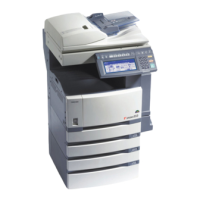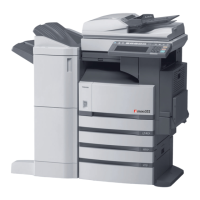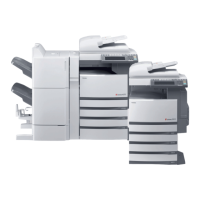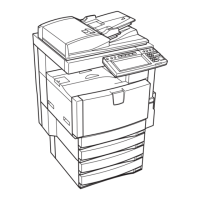
Do you have a question about the Toshiba e-STUDIO350 and is the answer not in the manual?
| Print Speed (Black/A4) | 35 ppm |
|---|---|
| Copy Speed (A4) | 35 cpm |
| Copy Resolution | 600 x 600 dpi |
| Scanner Type | Flatbed, ADF |
| Standard Paper Capacity | 550 sheets |
| Duplex Printing | Yes |
| Connectivity | Ethernet, USB |
| Original Size | A3 |
| Functions | Copier, Printer, Scanner |
| Scan Resolution | 600 dpi |
Procedures for safe transportation and installation of the equipment, including weight and clearance requirements.
Comprehensive list of error codes displayed on the screen, their classification, contents, and troubleshooting steps.
Procedure to check all LEDs and LCD pixels on the control panel.
Procedure for adjusting the auto-toner sensor after replacing the developer material.
Steps for checking and adjusting output for main charger, developer bias, transfer charger, and separation charger.
Instructions for adjusting the doctor-to-sleeve gap for the developer unit using a doctor-sleeve jig.
Adjusting aligning position to rear side '-' and '+' for simplex copying.
Adjusting aligning position by loosening hinge screws and turning adjustment screw.
Adjusting reverse aligning position to rear side '-' and '+' for duplex copying.
Procedure to adjust the leading edge position of the RADF for simplex copying.
Procedure to adjust the leading edge position of the RADF for duplex copying.
Procedure to check the center line alignment for horizontal position.
Procedure to adjust the jogging plate width for the MJ-1022 finisher.
Procedure to adjust the alignment position for the MJ-1023/1024 finisher.
Procedure to adjust the staple position for the finisher unit.
Procedure to adjust the folding position for the saddle stitcher unit.
Procedure for adjusting sensor output for the puncher unit.
Operation to register the number of punch holes for finisher identification.
Procedure to adjust dogleg image deformation that occurs on the output paper.
Overview of the PM support mode, enabling viewing of part usage and counter clearing.
A systematic guide for diagnosing and resolving various error codes encountered with the equipment.
Troubleshooting steps for paper jams related to registration and exit sensors.
Troubleshooting steps for jams caused by the jam access cover being opened.
Troubleshooting steps for paper transport delay jams in MJ-1022 finisher.
Troubleshooting steps for stapling jams in MJ-1023/1024 finishers.
Troubleshooting steps for fuser unit abnormalities detected at power ON.











